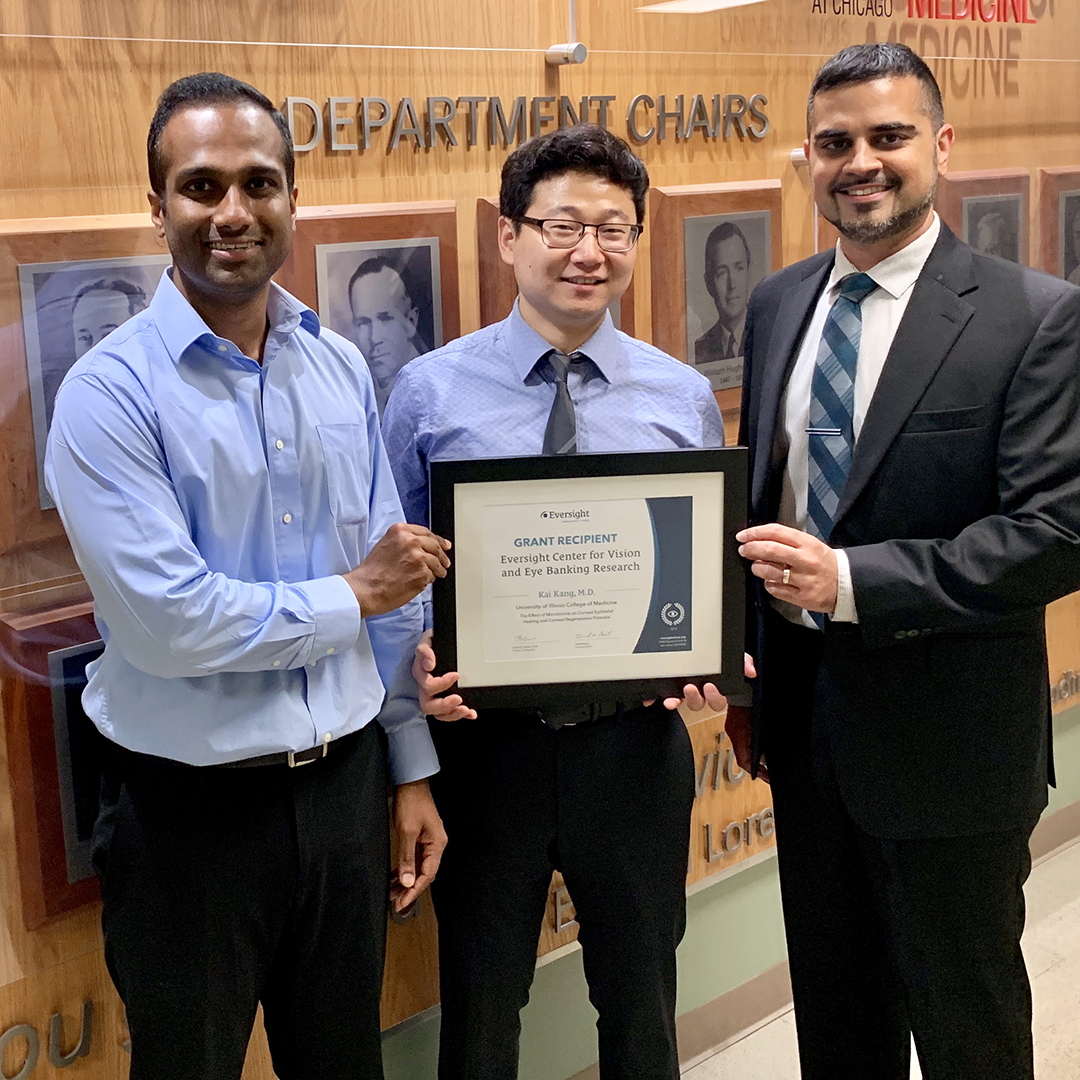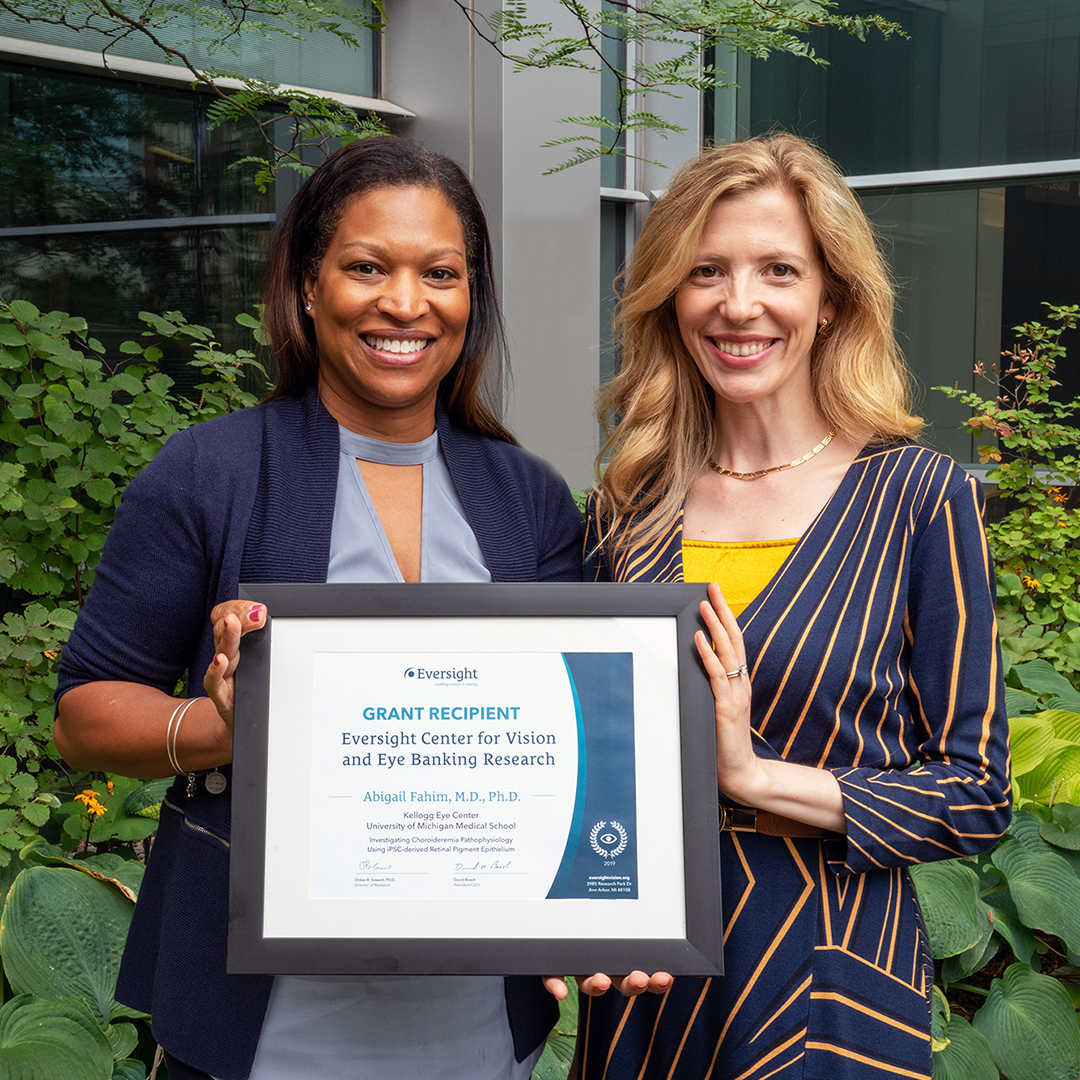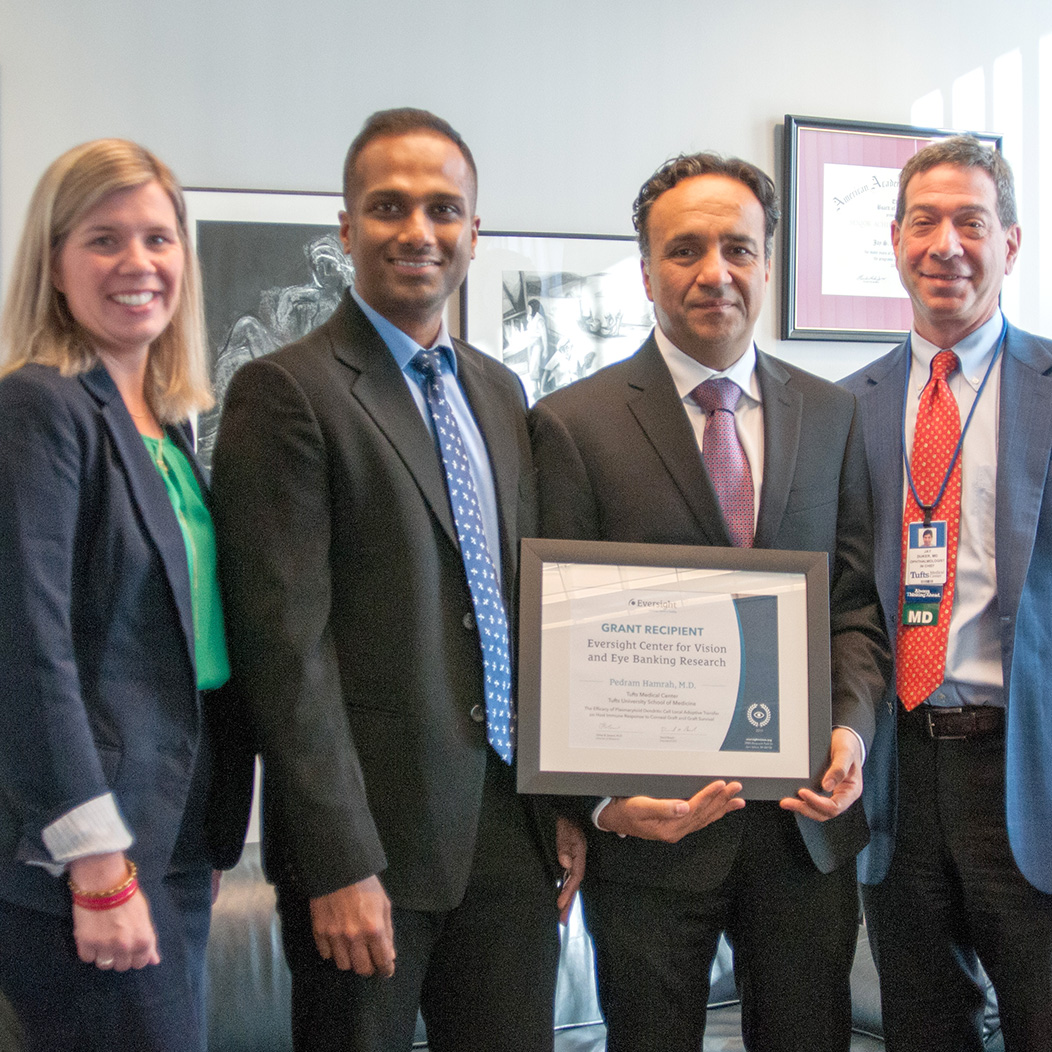


2025
2024
2023
Ghulam Mohammad, PhD, Research Assistant Professor, Ophthalmology, Visual and Anatomical Sciences, College of Medicine, Wayne State University, is investigating the link between epigenetics, oxidative stress and inflammation in the delayed epithelial wound healing in diabetic corneas. The outcome of this project is to enhance the overall understanding of the mechanisms underlying delayed epithelial wound healing in diabetic corneas.
2021-2022
2020-2021
2019
2018
Reza Dana, MD $20,000
Dr. Dana, professor of ophthalmology and vice chair for academic programs at Harvard Medical School, is investigating a cytoprotective neuropeptide called alpha-melanocyte stimulating hormone (α-MSH) and its effect on preventing or reducing corneal endothelial cell loss, one of the principle causes of corneal tissue graft failure.
Tomomi Ichinose, MD, PhD $20,000
In her study, Dr. Ichinose, an assistant professor at Wayne State University School of Medicine, will use donated human post-mortem eyes to explore the neural networks in the central retina, a small portion of the eye responsible for high-resolution vision, and obtain a more precise understanding that could lead to new disease therapies and retinal prostheses.
James D. Reynolds, PhD $20,000
An associate professor at Case Western Reserve University, Dr. Reynolds is pursuing a novel treatment method that could help people in need and improve patient care. An unexplored area in research is how donor status impacts small molecules that control many important body functions, including oxygen delivery and cell activity. Dr. Reynolds and his team, using a drug they designed, are conducting research to see if this treatment can be added to corneal storage solution, potentially improving the quality of tissue for transplantation and increasing the number of corneas available for transplant.
Nakul Shekhawat, MD $15,000
Dr. Shekhawat, clinical instructor in the Department of Ophthalmology and Visual Sciences at the University of Michigan, is leading a project to identify people diagnosed with herpes simplex virus keratitis (HSVK) and herpes zoster ophthalmicus (HZO), painful and recurrent conditions that are major causes of blindness. Dr. Shekhawat and his team hope to identify the risk factors associated with the re-emergence of these infections. This information could improve quality of care and stimulate new avenues of research in order to reduce the burden of these debilitating and potentially blinding conditions.
Pawan Kumar Singh, PhD $20,000
Dr. Singh, research scientist at Wayne State University School of Medicine, is investigating the role of the Zika virus (ZIKV) in glaucoma pathobiology, an emerging viral pathogen that can lead to severe ocular complications in newborn infants born to Zika-infected mothers. Dr. Singh’s research is addressing a pressing need to investigate the link between ZIKV and glaucoma in order to develop new prognostic and therapeutic tools to combat this global health threat.
2017
Benjamin T. Aldrich, PhD $15,323
An assistant research scientist at University of Iowa Carver College of Medicine, Dr. Aldrich is testing the effects of different concentrations of coenzyme Q10 on mitochondrial respiration and cell death. Results of the study will help perfect a protocol for eye banks to improve how corneal tissue is stored, mitigating endothelial cell susceptibility and decreasing graft failures after cornea transplants.
Elizabeth A. Berger, PhD $20,000
Dr. Berger, an assistant professor in the department of anatomy and cell biology at Wayne State University School of Medicine, is investigating a protein, thymosin beta 4, and its effectiveness treating bacterial keratitis when used in tandem with ciprofloxacin.
Brenda L. Bohnsack, MD, PhD $15,000
An assistant professor in the department of ophthalmology and visual sciences at Kellogg Eye Center, Dr. Bohnsack is studying stem cells in the corneal stroma and endothelium that give rise to many craniofacial and eye structures. Her work will provide important insight into the pathogenesis of congenital corneal diseases.
Sheldon R. Gordon, PhD $15,000
Dr. Gordon, a professor in the department of biological sciences at Oakland University, is researching a protein his laboratory discovered on the surface of endothelial cells that could lead to a novel therapy for certain conditions like Fuchs’ dystrophy that can cause vision loss and blindness.
Pedram Hamrah, MD, FACS $20,000
Associate professor of ophthalmology at Tufts Medical Center, Dr. Hamrah is investigating plasmacytoid dendritic cells and their role in the maintenance and function of corneal nerves.
Linda D. Hazlett, PhD $20,000
A distinguished professor and interim vice dean of research and graduate programs at Wayne State, Dr. Hazlett is testing the hypothesis that glycyrrhizin, which is extracted from licorice root and possesses numerous pharmacological effects, can improve antibiotic effectiveness against multi-drug resistant corneal infections.
Ahmad Kheirkhah, MD $20,000
Dr. Kheirkhah, an instructor at Harvard Medical School and an investigator at Massachusetts Eye and Ear Infirmary, is researching how neuropeptides can enhance corneal endothelial cell survivability and in what way they can be used for a variety of conditions to reduce or prevent corneal blindness.
Han Peng, PhD $15,000
A research assistant professor in the department of dermatology at Northwestern University Feinberg School of Medicine, Dr. Peng is researching a possible approach for improving the treatment of limbal stem cell deficiency—a problem often not recognized and treated in its early stages and may lead to corneal ulceration, scarring, chronic pain and vision loss.
Shunbin Xu, MD, PhD $15,000
Dr. Xu, an associate professor at Wayne State University School of Medicine, is investigating micro-ribonucleic acids, which can play important roles in inherited retinal diseases when they are defective.
2016
Patrice Fort, PhD, University of Michigan Kellogg Eye Center Award: $20,000
Dr. Fort, a Research Assistant Professor of Ophthalmology and Visual Sciences at the University of Michigan Kellogg Eye Center, will investigate regional alternations of the human retinal transcriptome during diabetes. Diabetic retinopathy remains a major public health problem due to an incomplete understanding of the condition’s pathophysiology. The goal of the study is to garner a greater insight into the role and regulation of alpha-crystallin protein function in the retina, and how this is modulated by diabetes.
Ula V. Jurkunas, MD, Massachusetts Eye and Ear Infirmary Award: $16,529
A clinician-scientist practicing at the Massachusetts Eye and Ear Infirmary in Boston, Dr. Jurkunas is an Associate Professor of Ophthalmology at Harvard Medical School and Associate Scientist at the Schepens Eye Research Institute. Dr. Jurkunas will examine the role of aberrant DNA damage response in Fuchs Endothelial Corneal Dystrophy (FECD) and its effect on the trinucleotide repeat expansion in the TCF4 gene. The grant will allow Dr. Jurkunas and her team to begin research to clarify an unexplained link between expansion of CTG repeats in TCF4 and the effect of oxidative stress-driven nuclear DNA damage. The investigation intends to provide a novel link between the observed cellular effects and the most significant genetic determinant of FECD, helping identify the pathway aberrantly regulated due to oxidative stress.
Shahzad Mian, MD, University of Michigan Kellogg Eye Center Award: $20,000
Dr. Mian, the Terry J. Bergstrom Collegiate Professor for Resident Education in Ophthalmology and Visual Sciences at the University of Michigan Medical School, will lead a pilot study assessing the feasibility and efficacy of pre-loaded corneal grafts for Descemet Membrane Endothelial Keratoplasty. He will conduct a preliminary study to develop an optimal corneal tissue delivery method, which will provide tissue completely stripped, trephined and stored in an injector, ready for implantation on the day of surgery without physician manipulation.
Padmanabhan Paranji Pattabiraman, PhD, Case Western Reserve University Award: $20,000
Dr. Pattabiraman, a Research Scientist at the Case Western Reserve University Department of Ophthalmology and Visual Sciences, is researching primary open-angle glaucoma (POAG), a potentially blinding disease mostly occurring in older adults and characterized by an excess buildup of a proteinaceous, a glue-like material blocking the minute pathway that drains fluid from the eye. The rising pressure can lead to blindness if left untreated. Dr. Pattabiraman will investigate the composition of the material deposits using a combination of two techniques, liquid chromatography and mass spectroscopy. Once the components of the POAG material are identified, Dr. Pattabiraman’s team will compare POAG patients with age-matched, non-affected subjects, leading to a better understanding of the underlying mechanism of the material’s formation.
Jessica M. Skeie, PhD, Carver College of Medicine Award: $15,611
Dr. Skeie, an Assistant Research Scientist/Engineer at the Carver College of Medicine in Iowa, will investigate the metabolic optimization of endothelial keratoplasty graft tissue preparation, as she tries to determine if the viability of corneal transplant tissue can be improved by treating it with antioxidant molecules before surgery. The implications of Dr. Skeie’s research on partial-thickness corneal transplantation could be significant. Demand is increasing for eye banks like Eversight to prepare partial-thickness tissue grafts, which replace a patient’s affected corneal endothelium, the inner lining responsible for maintaining a clear cornea. But approximately one third of the cells in a partial-thickness cornea transplant do not survive the first six months after surgery, and that can lead to a loss of corneal clarity. Dr. Skeie and her team will test whether donor endothelial cells exposed to antioxidant molecules can improve cell viability following tissue preparation for partial-thickness transplants. The research is also intended to help improve the understanding of the mechanisms involved in corneal endothelial cell health, and how to reduce or eliminate adverse effects on transplant tissue.
K.P. Connie Tam, PhD, Cleveland Clinic Lerner College of Medicine Award: $20,000
Dr. Tam, an Assistant Professor of Ophthalmology at the Cleveland Clinic Lerner College of Medicine, will investigate whether antibacterial eye drops can help prevent or reduce the severity of the disease caused by Pseudomonas aeruginosa, a major bacterial pathogen, which can lead to serious eye infections. The implications of Dr. Tam’s project could lead to better optimization of the use of keratin antimicrobial eye drops, resulting in novel anti-infective therapeutics for combating infections of the cornea and other sites.
Sarah Wood, OD, MS, University of Michigan Kellogg Eye Center Award: $15,000
Dr. Wood, a Clinical Instructor of Ophthalmology and Visual Sciences at the Kellogg Eye Center, will study a new treatment called Intense Pulsed Light (IPL) for the treatment of dry eye disease, which often causes debilitating inflammation of the eyes and is suspected of compromising surgical outcomes and patient satisfaction following cataract and refractive surgery and corneal transplantation. Additional studies are critical to a better understanding of the potential for IPL to minimize objective measures of dry eyes and improve patient quality of life.
Charles Yu, MD, University of Illinois Eye and Ear Infirmary Award: $15,000
Dr. Yu, an Assistant Professor of Ophthalmology at the University of Illinois Eye and Ear Infirmary in Chicago, is working to develop an advanced artificial cornea, a keratoprosthesis, often used when a corneal transplant is not possible because of a prior rejection, or excessive ocular damage. Currently, a keratoprosthesis operation requires a three-piece plastic device sandwiched around a donor cornea and sutured into the eye of the patient. While it offers short term visual improvements, patients often lose vision due to complications like membrane formation around the device. Dr. Yu’s one-piece keratoprosthesis requires a smaller incision resulting in faster patient recovery and does not require the use of donor tissue like existing devices. If successful, this artificial cornea could become available for human clinical trials and eventually be used for curing corneal blindness.
Cheng Zhang, MD, New York Montefiore Medical Center, Albert Einstein College of Medicine Award: $15,000
Dr. Zhang, an Assistant Professor, Ophthalmology, Montefiore Medical Center, Albert Einstein College of Medicine and the Director of Ocular Pathology & Neuro-Ophthalmology Divisions, will investigate the possibility of developing a novel therapy for corneal wound healing and nerve regeneration. The project will explore if it is possible to enhance the healing process of skin wounds from corneal abrasion injuries by utilizing two new physical treatments, siRNA and nanotechnology. Dr. Zhang’s team will target the protein Fidgetin-like 2 by delivering small interfering RNA through nanoparticles, and the research could develop an innovative therapeutic healing agent.
Sudha K. Iyengar, PhD, Case Western Reserve University Award: $20,000
Dr. Iyengar, the Vice Chair for Research at the Case Western Reserve University (CWRU) Center for Clinical Investigation and a CWRU professor of epidemiology and biostatistics, is aiming to change the paradigm for the classification of Fuchs’ endothelial corneal dystrophy (FECD) and assist eye banks in selecting the best tissue for cornea transplants. Dr. Iyengar’s goal is to identify biomarkers of FECD that will help doctors understand why some individuals are more at risk for the disease.
Jin-Hong Chang, PhD, University of Illinois at Chicago, Award: $15,000
Dr. Chang, a Research Assistant Professor of Ophthalmology and Visual Sciences at University of Illinois at Chicago, will examine corneal neovascularization caused by severe corneal injuries and infections that lead to blindness. He hopes to characterize corneal angiogenesis and lymphangiogenesis by looking at different proteins in both normal and injured eyes. If successful, the project will provide better understanding of the mechanisms associated with corneal neovascularization and could develop therapeutic interventions for treatments of angiogenesis-related diseases.


